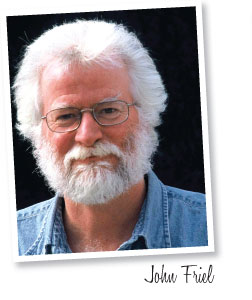1/1/2023
Swarthmore Redux: How the Other Half Rolls
John Friel

Last month, This Space focused on the then-recent Perennial Plant Conference at Scott Arboretum. But I only recapped half the speakers including, natch, Martha Stewart.
Swarthmore draws a savvy audience, not easily star-struck. I’ve never seen that crowd whip out more cameras than when Martha posed onstage with the other speakers. Let’s catch up on them.
Mike Bone has been at Denver Botanic Garden for 20 years, first as a propagator, now as globe-trotting Associate Director of Horticulture and Curator of Steppe Collections.
Steppes are dry, grassy plains whose soils and available moisture can’t support trees. Worldwide, there are four big ones. The largest, the Eurasian Steppe, stretches from Hungary to China. Ours is pretty big, too; we call it the American Prairie, or the Great Plains.
Mike showed us Dracocephalum grandiflorum, a small perennial with a stunning blue flower. Native to Siberia, it works well in America’s steppe, too. Elsewhere, one must site it perfectly; it demands better drainage than many of us can provide. But, oh, that color!
Mike quotes DBG’s Senior Curator, Panayoti Kelaidis: “If you can’t be with the soil you love, love the soil you’re with.”
Wambui Ippolito had a good year in 2021. Her design won Best in Show at the Philadelphia Flower Show and luxe shelter mag Veranda named her among “Eleven Revolutionary Female Landscape Designers and Architects You Should Know.”
Wambui’s presentation, “Landscapes That Connect New Communities with Perennial Plants,” was quite a globe-trotting hour—not surprising from a graduate of New York Botanical Garden’s School of Horticulture who grew up in Kenya.
Wambui’s early influences included her mother’s Nairobi garden and her grandmother’s farm. In America, she found many familiar plants from those childhood landscapes. We call them ornamentals; she knew them as edibles and medicinals. Stripped of that context, grown to please the eye, agapanthus and kniphofia “didn’t make sense” to her.
Reminding us that collectors nearly drove African violets (Saintpaulia) to extinction to decorate First World windowsills, she said, gently, “A true plant lover can enjoy a plant and walk away.”
A favorite image: Grass plumes, specifically Tetrapogon roxburghiana, backlit and glowing.
“African grasses are best seen in the evening light, massed,” Wambui said. That’s true everywhere. Grass plumes are finely divided, natural diffusers of light. In the low morning or evening sun, they’re dazzling.
Janet Novak gardens in Philadelphia, where, of necessity, she ignored Mike Bone’s earthy advice: She took great pains amending her compacted soil, mostly to improve drainage, creating, in effect, a low-maintenance, native-friendly limestone prairie. Her presentation was entitled “Matching Place to Plant: Expanding the Native Plant Palette.”
Janet’s collecting approach (her list covered four pages) clashes with Wambui’s assertion that plants from diverse sources don’t make sense together. I’m with Wambui. A favorite: Sedum ternatum, one of America’s few native succulents, thrives in dry shade.
Epilogue
Like responsible organizers everywhere, the Swarthmore committee strives to shrink the day’s carbon footprint. With live events (happily) a thing again, such concerns are (rightfully) front-of-mind again.
Conflict: Plant lovers love lists, especially when the plants are unfamiliar and well-photographed. We want those names, correctly spelled, for reference next spring. Going paperless via QR codes and PDFs seems admirably green, but creates annoying distractions.
You’re in a dark auditorium, admiring a presenters images. Do you really want a tablet shining in your left eye, a smartphone in your right? I don’t.
Kind speakers include names in their slides, but that leaves listless attendees scribbling in the dark or—worse—raising their devices to capture the screen, blocking the view of the unlucky folks behind them like beefy fans who won’t sit down at the ballgame. We want that name, underlined and circled.
Until further notice, paper wins. The dead tree lives. GP
John Friel is marketing manager for Emerald Coast Growers and a freelance writer.